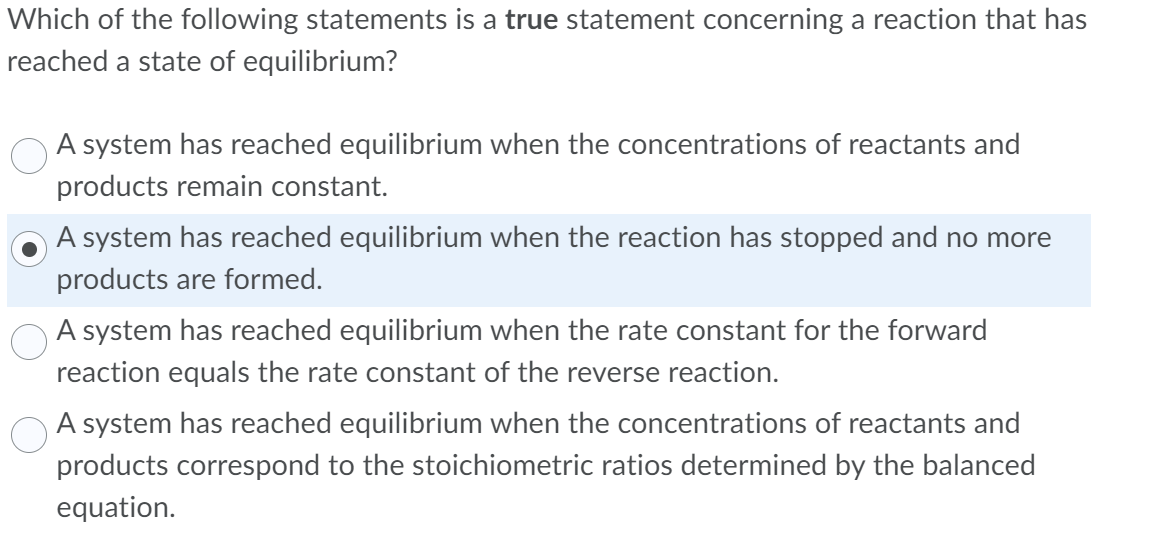Which of the following statements is a true statement concerning a reaction that has reached a state of equilibrium? A system has reached equilibrium when the concentrations of reactants and products remain constant. A system has reached equilibrium when the reaction has stopped and no more products are formed. A system has reached equilibrium when the rate constant for the forward reaction equals the rate constant of the reverse reaction. A system has reached equilibrium when the concentrations of reactants and products correspond to the stoichiometric ratios determined by the balanced equation.
Which of the following statements is a true statement concerning a reaction that has reached a state of equilibrium? A system has reached equilibrium when the concentrations of reactants and products remain constant. A system has reached equilibrium when the reaction has stopped and no more products are formed. A system has reached equilibrium when the rate constant for the forward reaction equals the rate constant of the reverse reaction. A system has reached equilibrium when the concentrations of reactants and products correspond to the stoichiometric ratios determined by the balanced equation.
Introductory Chemistry: A Foundation
9th Edition
ISBN:9781337399425
Author:Steven S. Zumdahl, Donald J. DeCoste
Publisher:Steven S. Zumdahl, Donald J. DeCoste
Chapter17: Equilibrium
Section: Chapter Questions
Problem 10CR: . Explain what it means that a reaction has reached a state of chemical equilibrium. Explain why...
Related questions
Question

Transcribed Image Text:Which of the following statements is a true statement concerning a reaction that has
reached a state of equilibrium?
A system has reached equilibrium when the concentrations of reactants and
products remain constant.
A system has reached equilibrium when the reaction has stopped and no more
products are formed.
A system has reached equilibrium when the rate constant for the forward
reaction equals the rate constant of the reverse reaction.
A system has reached equilibrium when the concentrations of reactants and
products correspond to the stoichiometric ratios determined by the balanced
equation.
Expert Solution
This question has been solved!
Explore an expertly crafted, step-by-step solution for a thorough understanding of key concepts.
This is a popular solution!
Trending now
This is a popular solution!
Step by step
Solved in 2 steps with 2 images

Knowledge Booster
Learn more about
Need a deep-dive on the concept behind this application? Look no further. Learn more about this topic, chemistry and related others by exploring similar questions and additional content below.Recommended textbooks for you

Introductory Chemistry: A Foundation
Chemistry
ISBN:
9781337399425
Author:
Steven S. Zumdahl, Donald J. DeCoste
Publisher:
Cengage Learning

Introductory Chemistry: An Active Learning Approa…
Chemistry
ISBN:
9781305079250
Author:
Mark S. Cracolice, Ed Peters
Publisher:
Cengage Learning

Chemistry: Matter and Change
Chemistry
ISBN:
9780078746376
Author:
Dinah Zike, Laurel Dingrando, Nicholas Hainen, Cheryl Wistrom
Publisher:
Glencoe/McGraw-Hill School Pub Co

Introductory Chemistry: A Foundation
Chemistry
ISBN:
9781337399425
Author:
Steven S. Zumdahl, Donald J. DeCoste
Publisher:
Cengage Learning

Introductory Chemistry: An Active Learning Approa…
Chemistry
ISBN:
9781305079250
Author:
Mark S. Cracolice, Ed Peters
Publisher:
Cengage Learning

Chemistry: Matter and Change
Chemistry
ISBN:
9780078746376
Author:
Dinah Zike, Laurel Dingrando, Nicholas Hainen, Cheryl Wistrom
Publisher:
Glencoe/McGraw-Hill School Pub Co

Principles of Modern Chemistry
Chemistry
ISBN:
9781305079113
Author:
David W. Oxtoby, H. Pat Gillis, Laurie J. Butler
Publisher:
Cengage Learning

World of Chemistry, 3rd edition
Chemistry
ISBN:
9781133109655
Author:
Steven S. Zumdahl, Susan L. Zumdahl, Donald J. DeCoste
Publisher:
Brooks / Cole / Cengage Learning

General, Organic, and Biological Chemistry
Chemistry
ISBN:
9781285853918
Author:
H. Stephen Stoker
Publisher:
Cengage Learning